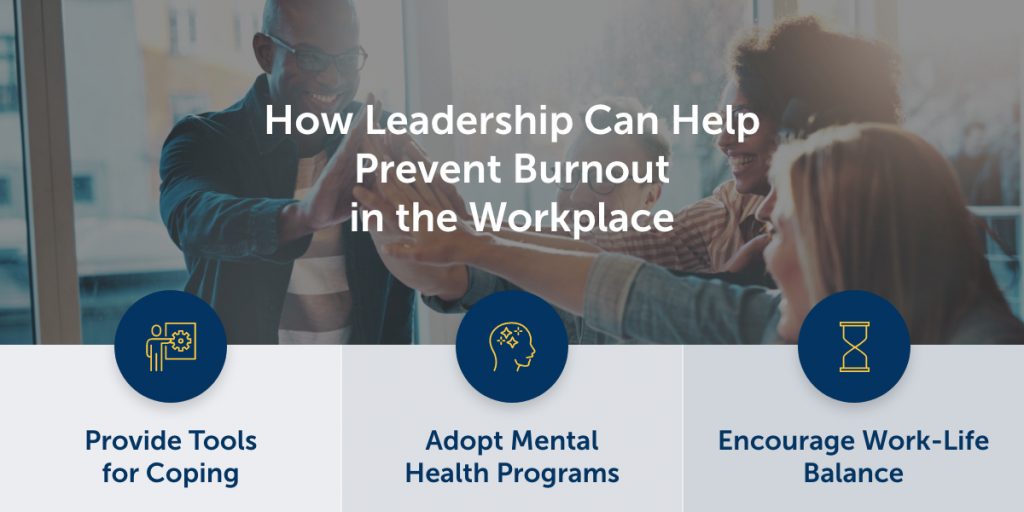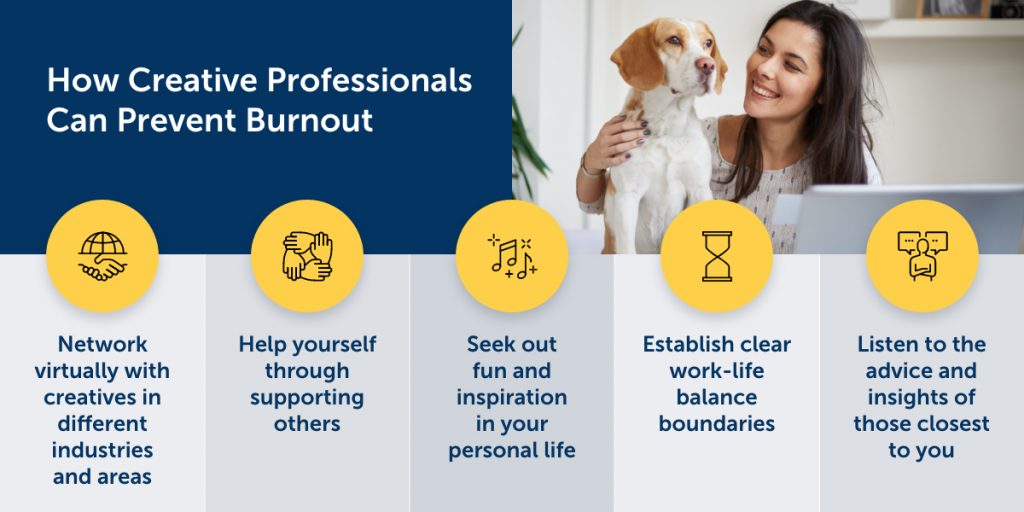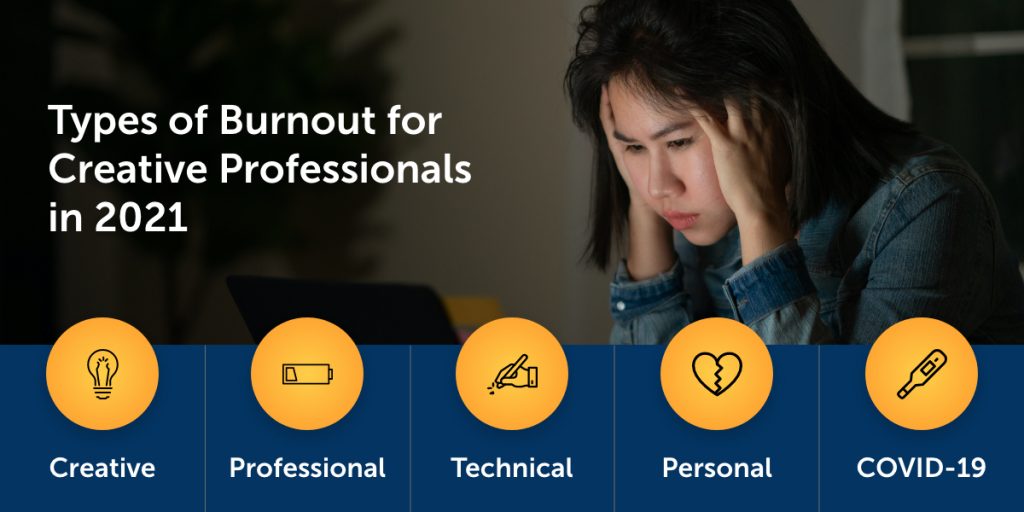Mental Health Resources to Help Prevent Creative and Professional Burnout
Creative and professional burnout — due to heavy workloads, long hours and lack of resources — affect 64 percent of tech professionals, according to ISACA’s Tech Workforce 2020 report. While burnout is not new, the COVID-19 pandemic has caused additional strain on an already stressed workforce, leading to a loss of productivity, physical fatigue, anxiety, insomnia and other physical and psychological symptoms. On top of all of that, creative tech professionals, like UX/UI designers, also have to cope with creative burnout, which can lead to an inability to think creatively or perform creative tasks.
Up until 2019, burnout was not recognized as a medical condition. However, it can now be found under the World Health Organization’s (WHO) International Disease Classification (ICD-11) — the official compendium of diseases — and is defined as a “syndrome conceptualized as resulting from chronic workplace stress that has not been successfully managed.” This condition often occurs after enduring a heavy workload over a long period of time in combination with stressful working conditions.
How can creatives cope with personal and professional pressures to break through burnout? This article will share key insights, actionable advice and takeaways from Charles-Henri Lison, a leading UX/UI professional who has researched and designed user experiences for organizations like Thomson Reuters, RACV and Target. We will also provide a list of resources with tools for assessing burnout, managing stress, talking about burnout with others and more.
The Correlation Between Creativity and Burnout
Creative professionals often think of their creativity as part of their identity; it’s who they are, as Lison puts it. So what happens when the trait you associate with your identity becomes a source of tension and anxiety? Acclaimed neuroscientist and published psychiatrist Nancy Andreasen explores this dichotomy in The Creative Brain. One of the book’s key takeaways is the empirical evidence correlating creativity and burnout, and the explanation for why creative types are more prone to the condition.
Andreasen explains that creative people have to confront doubt and rejection — and yet they have to persevere in spite of that, because they deeply believe in the value of what they do. This can result in a creative block as well as various forms of burnout that deviate from its medical definition. Here are some of the unique forms of burnout that creative professionals may face.
- Creative Burnout: This is a state of emotional, physical and mental exhaustion around creative work, according to mindful productivity site NessLabs. The symptoms of creative burnout can include constant exhaustion, inexplicable stress, morning dread, harmful habits, irritability, self-doubt and struggling to do basic work, among other symptoms.
- COVID-19 Burnout: Burnout is no longer exclusively tied to job-related stress. According to a recent State of Burnout: Covid-19 survey of 7,000 American professionals, over 70 percent of participants were feeling burned out due to the pandemic. The top reasons included a lack of separation between work and home, unmanageable workloads and worries over job security.
- Professional Burnout: This is a unique type of stress syndrome that is characterized by emotional exhaustion, according to a stress management research report. According to psychiatric nurse practitioner Dr. Melissa DeCapua, risk factors for professional burnout are sometimes referred to as the “big four”: lack of control over work conditions, time pressure, chaotic workplaces and lack of alignment on values.
- Technical Burnout: The tech industry can be rewarding, but it can come with a fast-paced work environment, high expectations and immense pressure on employees. According to survey data from Spiceworks, an IT social network, most full-time tech pros work in excess of 50 hours per week. Over time, these long hours can contribute to employee unhappiness and burnout.
- Personal Burnout: Unlike professional burnout, personal burnout is often caused by non-work related stressors, and is evaluated separately. It can result in a combination of emotional exhaustion, depersonalization, reduced personal accomplishment and a feeling of detachment from others.
The Role of Leadership in Preventing Burnout

According to Lison, leadership plays a significant role in enhancing work engagement and decreasing burnout among employees. Many tend to think of burnout as an individual problem that can easily be fixed by working less or shifting to a new position. However, burnout can happen to anyone, and preventing it starts with leadership, says Lison. By taking the proper steps to foster a mentally healthy workplace, leaders can work to eliminate the stigma and help prevent burnout.
Here are some key insights from Lison on how leadership can achieve this in their organization:
1. Provide Tools for Coping
Organizations can improve their employees’ productivity and output while decreasing their chance of burnout by ensuring that workers have the proper tools and resources available to them. This may include burnout assessments, stress indicators and self-care questionnaires so employees can recognize the signs of burnout and begin to address them.
2. Adopt Mental Health Programs
Lison recommends that organizations adopt mental health programs to help employees address concerns about burnout. He suggests that an on-site psychologist or tele-health platform could be very beneficial in helping employees not only identify the signs of burnout, but also treat those symptoms.
3. Encourage Work-Life Balance
Maintaining a healthy work-life balance is essential to preventing burnout. Additionally, companies that promote work-life balance record two times more productivity than those that do not, according to Deloitte. Leaders can achieve this work-life balance by allowing employees to work from home, take frequent breaks, schedule work around personal life and allowing disconnect from work during non-work hours.
Tips for Individuals on Preventing Burnout
If you’d like to know more about how creatives can cope with personal and professional pressures to break through burnout, here are 11 ways to get started:
- Separate work life and personal life
- Recognize the signs of mental health distress
- Utilize mental health resources and applications
- Embrace life, make time for it and cultivate fun
- Schedule calls to socialize with your coworkers
- Take a vacation and fully unplug from any work commitments
- Find time to exercise every day
- Dedicate time to interact with friends and family
- Start using positive self talk exercises
- Build a comfortable and ergonomic workspace
- Invest time in helping others
Ways Creatives Can Stay Inspired Amidst Burnout

Here are some additional tips from Lison and other thought leaders on how creatives can stay inspired when they’re faced with creative block or burnout:
- Try virtual networking with other creatives to get inspired and share ideas: Since many activities have moved online due to COVID-19, take the opportunity to connect with people outside of your work environment or geographic area.
- Check in on colleagues and offer to help them if they’re struggling: Assisting your colleagues may help them feel valued and supported, while also reinvigorating and inspiring you in new and unexpected ways.
- Enjoy a fun new activity outside of work: The things you learn and experience while doing something you enjoy in your personal life may bring unexpected inspiration and motivation for that work problem you’ve been trying to solve.
- Set boundaries and work to preserve them: Establishing a clear work-life balance is not only important for your success and happiness as an individual, but can encourage others to set their own boundaries as well.
- Lean on your friends and mentors for guidance: Sometimes the people in your life will notice trends in your feelings and behaviors that you overlook yourself. When friends or mentors mention that you seem stressed or overwhelmed, listen to them. Take steps to stave off burnout before it becomes too much.
Free Mental Health Resources for Preventing Burnout
Identifying Burnout — Free Assessment Tools
- Mind Tools Burnout Self-Test — This self-test can help you determine if you are at risk for burnout by helping you assess the way you feel about your job and your work experiences.
- Job Burnout Quiz: How Close Are You To Burning Out? — See if you’re close to burning out by taking this job burnout quiz designed to assess the warning signs.
- Burnout Self Test (Printable Chart) — This printable stress and burnout questionnaire can help you identify potential warning signs in your life.
- What Causes Employee Burnout in the Tech Industry? — This article can help you identify the causes of burnout as they specifically relate to the tech industry.
- Burnout Test — This Psychology Today test offers a free snapshot report with a summary evaluation and graph of your results.
Resources for Creatives, UX/UI Professionals and Designers
- Surefire Cure-alls For UX Burnout — Here are six remedies that can help you maintain an energized and creative approach to UX design.
- How to Avoid UX Burnout — Explore six types of UX burnout you may encounter, along with research-backed methods to get through them.
- 6 Tips for Self-Care as a Remote UX Designer — This article shares several tips for keeping your mind and body healthy while building a remote UX career.
- Curb Creative Burnout: 8 Techniques Designers Swear By — If you feel burnout creeping in, lean on advice from these designers to reignite your creative spark and push past the rut.
- How to Keep UX Burnout at Bay? — Here are five tried and tested research-backed remedial measures to get through UX burnout.
Self Care Exercises
- Self-Care Assessment (Printable Worksheet) — This printable self care assessment worksheet was designed to help you develop effective strategies for self care.
- Avoiding Burnout: 10 Tips for Self-Care — Lynn Louise Wonders, LPC, CPCS, RPT-S, shares ten tips for avoiding burnout and creating a self care plan.
- 23 Creative Self-Care Activities for Groups — These detailed, science-based exercises can help you increase your own self care, but will also give you the tools to help others.
- 5 Steps for Women to Combat Burnout — Written by Ellen Keithline Byrne, a co-founder of a leadership consulting firm focusing on advancing women in leadership, the steps outlined in this article can help women identify and address burnout.
- 8 Practical Ways to Make Your Tech Job Less Stressful — Here are eight tips from C-suite tech professionals and thought leaders on making your tech job less stressful.
Resources for Employers
- Is Your Staff Burning Out? –— Created by Dr. Beverly Potter, this printable worksheet offers a questionnaire for employers to determine if their staff is suffering from burnout.
- The Ultimate Workplace Mental Health Toolkit — This toolkit from Launchways and NAMI provides the resources for establishing a mental health program within the workplace.
- 12 Signs Your Tech Employees Are Burnt Out (Infographic) — This eye-catching infographic shares 12 signs for identifying burnout among your employees.
- Tech Workers Suffering From Burnout By Company — This article by BusinessInsider reveals a list of companies that have high levels of burnout, as reported by employees.
- Global IT Burnout Index — Discover your burnout risk with a science-based assessment powered by Yerbo.
Resources for Talking to Your Boss About Burnout
- How to Tell Your Boss You’re Burned Out — This Harvard Business Review shares advice on disclosing burnout out to your employer.
- How to Talk to Your Boss About Mental Health — This article shares five ways to bring up mental health concerns with your boss.
- Disclosing a Mental Health Condition at Work — This article looks at the benefits of talking about mental health at work as well as making a plan to disclose a condition.
- How to Talk to Your Boss About Burnout, According to an HR Exec — Here is a list of tips from a human resources professional on talking to your boss about burnout.
Stress Management/Mindfulness Apps
- Headspace — Get happy, stress less, sleep soundly and learn meditation and mindfulness skills from world-class experts.
- Calm — This is a mindfulness app for both newcomers and meditation enthusiasts alike. Explore hundreds of meditations while improving your technique.
- Insight Timer — This is a platform for meditation teachers, organizations and musicians to share conscious content with millions of users like yourself.
- Buddhify — This app is designed to introduce users to techniques of urban meditation while developing a state of mindfulness and well-being in everyday life situations.
- Sattva — Track your meditation practice with a journey and browse thought collections and playlists designed to inspire your sessions.
- Mindfulness Coach — This free tool offers an activity log and daily mood rating features to help users learn to use mindfulness to cope with unpleasant thoughts and emotions.
- Project Return Peer Support Network — Designed for individuals coping with mental health concerns and who need a peer to talk to while traditional services are closed.
Resources to Help You Stay Connected Remotely
- FaceTime — If you’re an Apple user, you’ve likely heard of FaceTime. Try using it to connect with some of your friends and family members.
- Marco Polo — If you want to video chat with a friend or family member, but can’t do so in real time because they have a busy work schedule, this app is for you.
- Netflix Party — Find a new way to watch TV with your friends online. Netflix Party synchronizes video playback and includes group chat functionalities within the Netflix streaming platform.
- Bunch — This app allows you to see your friends’ faces when playing mobile games together. Just pick your favorite game and start playing.
- Zenly — Turn quarantine into a game by broadcasting your location to your friends, while keeping track of who is staying indoors.
The inclusion of these apps and resources is for educational purposes only and does not constitute an endorsement by Berkeley Boot Camps
 Live Chat
Live Chat
